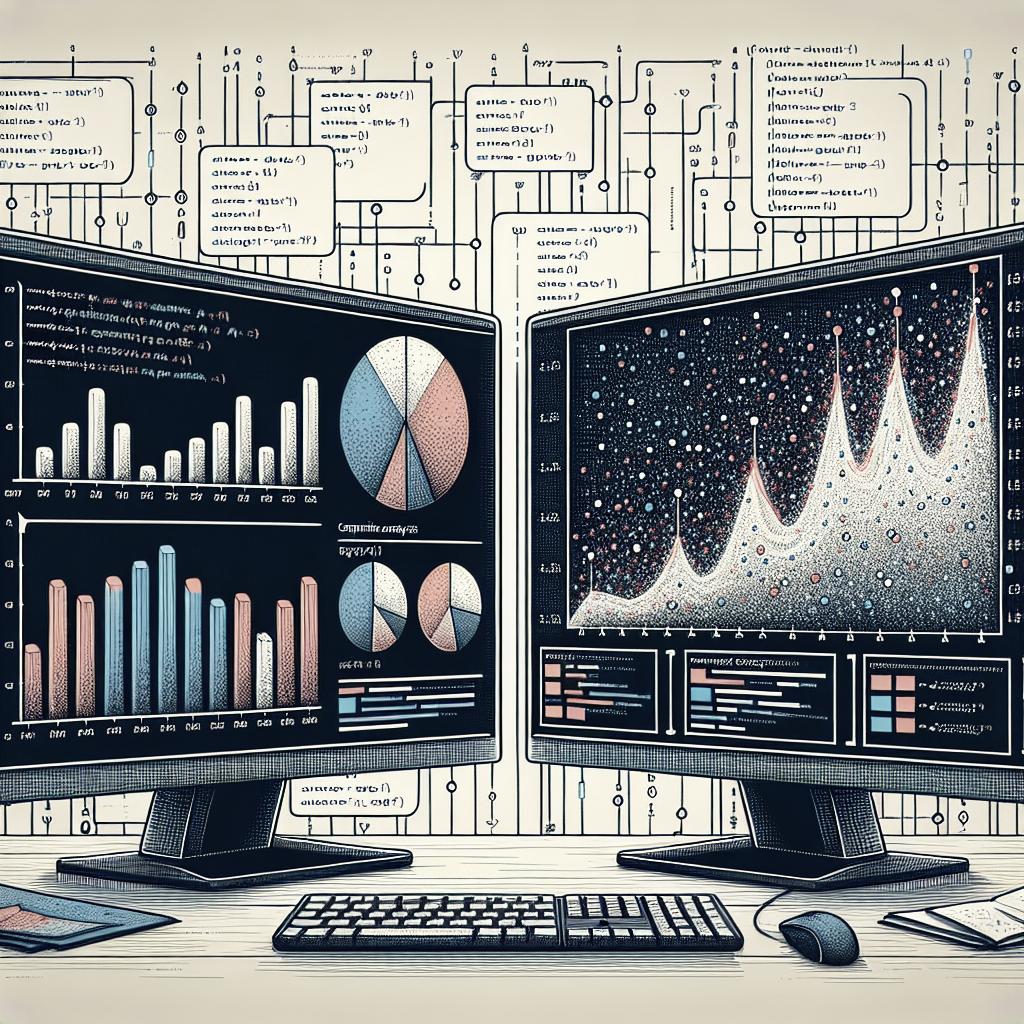GGPlot2 for Beginners Tutorial
Introductory Words
Welcome to this comprehensive guide on mastering the basics of
ggplot2
, an essential package in
R for data visualization that allows you to produce graphics with great flexibility and detailing. Whether
you’re just starting with R or looking to enhance your data visualization skills, this tutorial is tailor-made
for beginners. Here, we will walk you through the essential elements, from preparing your dataset and
constructing a basic plot to customizing your graphics with various themes and colors. By the end of this guide,
you’ll have the foundation needed to leverage
ggplot2
for creating insightful and visually
captivating plots.
Table of Content
- Preparation
- The Dataset
- The {ggplot2} Package
- A Default ggplot
- Working with Axes
- Working with Titles
- Working with Legends
- Working with Backgrounds & Grid Lines
- Working with Margins
- Working with Multi-Panel Plots
- Working with Colors
- Working with Themes
- Working with Lines
- Working with Text
- Working with Coordinates
- Working with Chart Types
- Working with Ribbons (AUC, CI, etc.)
- Working with Smoothings
- Working with Interactive Plots
- Remarks, Tipps & Resources
Preparation
Before diving into
ggplot2
, ensure you have R and RStudio installed on your computer. This
integrated development environment provides a user-friendly interface and tools to facilitate coding in R. You
can download R from CRAN and RStudio from its official website.
Once you have your environment set up, open RStudio and install the
ggplot2
package by running this
command:
install.packages("ggplot2")
. You may also want to load the library using
library(ggplot2)
to access its functions during your session. With these steps completed, you’re
prepared to start creating impressive visualizations.
The Dataset
In any data visualization task, a dataset is the foundation. For this tutorial, we will use the popular
mtcars
dataset that comes preloaded with R. This dataset contains various specifications of
automobile models, providing ample variables to plot and analyze.
To load the dataset into your R environment, simply use
data(mtcars)
. You can explore the
dataset’s structure with
str(mtcars)
and get a feel for the types of visualizations you can
create. With
ggplot2
, even such introductory datasets can be turned into informative visual
stories.
The {ggplot2} Package
Developed by Hadley Wickham,
ggplot2
is based on the Grammar of Graphics, providing a strong
framework for detailing data visualizations. The package has become a cornerstone for data scientists because of
its flexibility and clarity.
ggplot2
allows you to create complex graphics with relative ease. Its layered approach enables you
to construct plots by adding layers iteratively, including data, geometries, scales, and annotations. The
package’s powerful syntax can be challenging at first, but this tutorial will guide you through its basic
principles and functions.
A Default ggplot
Starting with a default plot in
ggplot2
is quite straightforward. For example, you can plot the
mtcars
dataset showing miles-per-gallon against weight with
ggplot(mtcars, aes(x = wt, y =
mpg)) + geom_point()
. Here,
aes()
defines the mapping of the axes.
The function
geom_point()
adds points to your plot, making it a scatter plot. This simple plot
provides a base that you can build upon, adding more details to enhance its readability and depth.
Working with Axes
Customizing axes is crucial for ensuring that your plot communicates effectively. Use
xlab()
and
ylab()
to label axes, making sure your audience comprehends your data’s context at a glance.
Additionally, adjust the axis scales and limits with functions like
scale_x_continuous()
and
scale_y_continuous()
. This adjustment is essential when dealing with datasets that have varying
scales or require specific attention to data points within a range.
Working with Titles
Titles provide critical context and guidance for interpreters of your plot.
ggtitle()
is the
function used to add a title, allowing you to set the stage for the data insights displayed.
To further guide the viewer, subtitles can be included using
labs()
to specify additional text
with improved clarity. Well-chosen titles and subtitles can significantly increase the plot’s impact.
Working with Legends
In plots where multiple colors delineate different groups, a legend is indispensable. Use
scale_color_manual()
or similar functions to set custom legends, helping viewers decode what each color or symbol represents.
Additionally, the legend’s location, size, and text can be adjusted with commands such as
theme(legend.position)
, ensuring it complements rather than competes with the plot’s main elements.
Working with Backgrounds & Grid Lines
By default,
ggplot2
provides a grey background with white grid lines. Altering these can enhance your plot’s aesthetic or adapt it to publication standards. Customize the background using
theme()
, where you can change elements like
panel.background
.
Grid lines guide the viewer’s eyes but can be made less prominent or removed entirely with
panel.grid
settings. This customization refines your plots, allowing subtle emphasis on key data points.
Working with Margins
The spacing around the plot can affect how readable and accessible the information is. Margins can be adjusted to create whitespace or prevent overlap and crowding using the
theme()
function with
plot.margin
argument.
In particular, expanding margins may help if annotations or legends appear cramped, ensuring clarity and visual balance throughout the graphic.
Working with Multi-Panel Plots
Faceting creates subsets of data displayed in separate panel plots, ideal for comparative analysis. The
facet_wrap()
or
facet_grid()
allows for intuitive comparison by dividing data into logical groups.
This technique highlights differences and patterns among datasets, providing multi-perspective views within one cohesive graphic space.
Working with Colors
Color is a vital storytelling tool in data visualization. Use
scale_color_brewer()
or
scale_fill_brewer()
to access a spectrum of colors suited for various effects, from bright distinctions to monochrome palettes.
Consider accessibility, such as color blindness, when choosing colors —
viridis()
scale provides an accessible yet vibrant palette, facilitating inclusive and decipherable visuals.
Working with Themes
Themes are comprehensive styles that set the overarching aesthetic of your plots. Predefined themes like
theme_minimal()
,
theme_classic()
, or
theme_bw()
offer efficient ways to adjust the overall look.
Modify these themes further with the
theme()
function, altering font style, size, or plot margins, and tailor your plots for publications standards or personal preference.
Working with Lines
Lines in
ggplot2
, such as those created by
geom_line()
, are ideal for visualizing trends and relationships over intervals. Add them using
geom_smooth()
for linear regressions or trend lines.
Additionally, line types, widths, and colors can be adjusted for emphasis or distinction among datasets. This facility enables creating visually compelling narratives through graphical continuity.
Working with Text
Text plays a critical role in annotating plots. Whether it is labeling data points through
geom_text()
or adding annotations with
annotate()
, effective text use enhances plot readability significantly.
Text size, angle, and color customization help integrate annotations smoothly into the plot, ensuring they complement rather than clash visually with other plot elements.
Working with Coordinates
Coordinate systems define how data points are arranged in plots. The Cartesian coordinate system is default, but alternatives like
coord_flip()
or
coord_polar()
are used for specific plot types such as bar or pie charts.
Manipulating coordinate systems can result in innovative perspectives, enabling otherwise hidden pattern discoveries within the dataset.
Working with Chart Types
ggplot2
supports numerous chart types, like bar charts with
geom_bar()
, histograms with
geom_histogram()
, or box plots with
geom_boxplot()
. Each type serves specific analytical needs.
Choosing the right chart type is paramount for clear communication, and understanding the function and features of each helps convey data stories effectively, optimizing insights drawn from visual narratives.
Working with Ribbons (AUC, CI, etc.)
Ribbons in plots depict ranges of values, such as confidence intervals, using
geom_ribbon()
. These graphical elements add depth, showing variability and uncertainty within a dataset.
Ribbons can accompany lines or other geometries to enhance interpretability, allowing viewers a comprehensive understanding of data behavior across different metrics.
Working with Smoothings
Smoothing functions, such as
geom_smooth()
, overlay defined mathematical trends onto data, aiding insight into broader patterns or relationships not immediately obvious in raw data plots.
Common methods include LOESS smoothing, polynomial fits, or straightforward linear regressions, all contributing toward clearer, more cohesive visual storytelling when applied prudently within the plot context.
Working with Interactive Plots
While static plots are powerful, interactive plots created using packages like
plotly
or
ggiraph
allow viewers to explore data layers dynamically through direct plot manipulation.
Transforming ggplot objects into interactive ones extends accessibility, broadening data stories’ reach and utility, typically adding a layer of engagement absent from traditional static visuals.
Remarks, Tipps & Resources
Data visualization is an evolving field constantly enriched by community contributions and technological advancements. Resources like
ggplot2 official documentation
and community forums provide ongoing learning opportunities.
Always keep in mind the importance of clarity, clean data presentation, and audience consideration when designing plots. Various online courses and MOOCs can further provide structured guidance on advancing ggplot2 skills suited to your specific interest or field.
Summary of Main Points
| Topic | Key Focus |
|---|---|
| Preparation | Setting up R and RStudio; Installing ggplot2 |
| The Dataset | Introduction to mtcars and data exploration |
| The {ggplot2} Package | Overview of features and syntax based on Grammar of Graphics |
| Axes, Titles, Legends | Customizing plot labels, titles, and legends for effective communication |
| Backgrounds & Grid Lines | Improving plot aesthetics and readability with themes |
| Multi-Panel Plots | Using facets for comparative analysis |
| Colors, Themes | Enhancing plots with color palettes and set styles |
| Lines, Text, Coordinates | Detailing data relationships and annotations within plots |
| Chart Types | Understanding diverse visualization options within ggplot2 |
| Ribbons, Smoothings | Adding interpretability through visual embellishments |
| Interactive Plots | Enhancing engagement through dynamic explorations |
| Tips & Resources | Further reading and learning suggestions; community engagement |


